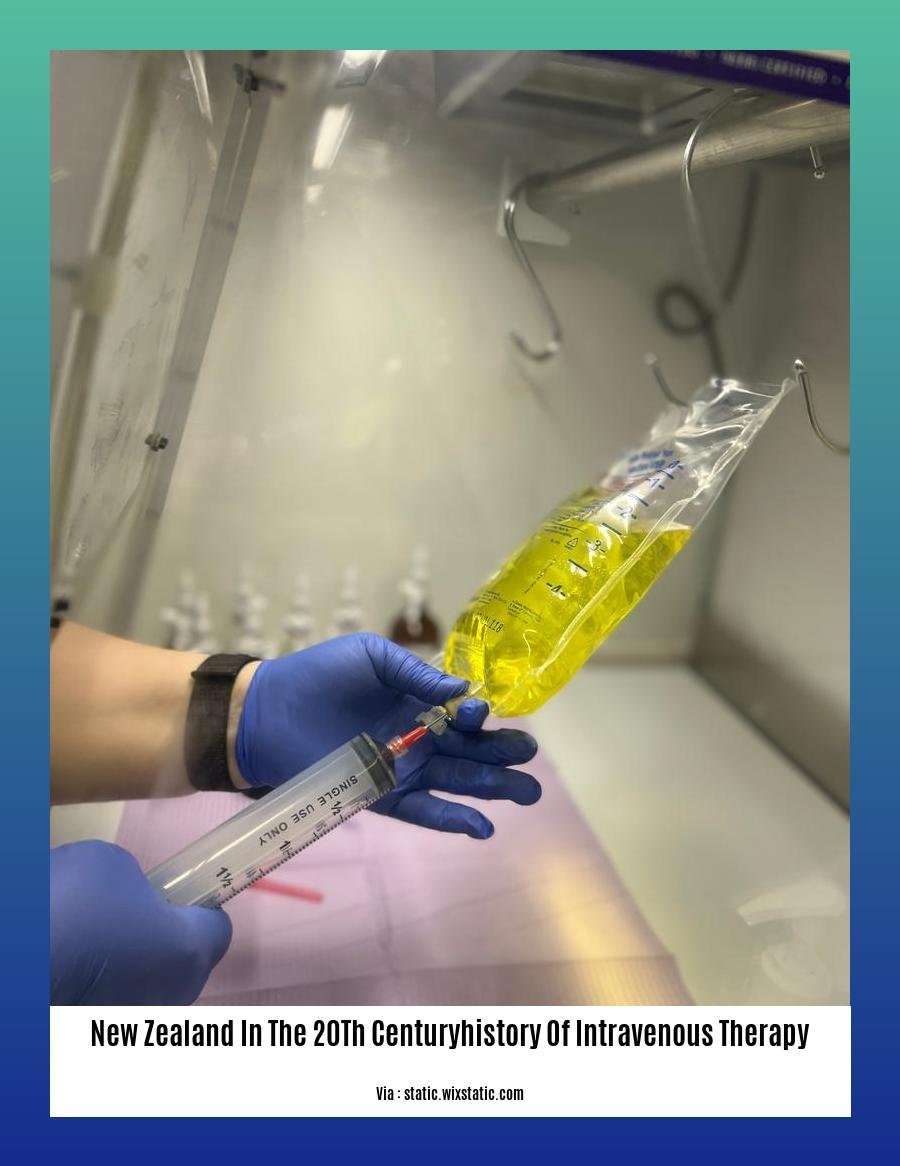The [History of Intravenous Therapy in New Zealand During the 20th Century] is a captivating exploration of the evolution of a life-saving medical practice. Join us as we journey through the advancements, challenges, and triumphs that have shaped the history of intravenous therapy in New Zealand.
Key Takeaways:
- Education on nursing skills such as IV therapy, venepuncture, and cannulation requires standardization.
- Different approaches to teaching these skills exist in New Zealand’s District Health Boards and nursing schools.
- The International Nurses Society on IV Therapy (INSIVT) has established a framework for IV therapy education.
- The INSIVT framework includes guidelines on IV therapy administration, venepuncture, and cannulation.
New Zealand in the 20th century: history of intravenous therapy

During the New Zealand in the 20th centuryhistory of intravenous therapy, this medical technique saw pioneering advancements that revolutionized patient care. Here’s a glimpse:
Early 20th Century – Pioneering Steps
- 1905: IV therapy’s introduction in New Zealand by Dr. Frederick Truby King, revolutionizing infant healthcare.
Mid-20th Century – Innovations Emerge
- 1940: Establishment of NZ’s first blood bank, enabling life-saving transfusions.
- 1950s: Development of safer, more effective IV fluids, enhancing treatment options.
Late 20th Century – Technological Advancements
- 1980s: Introduction of central venous catheters, allowing long-term IV access.
- Continuous development of precise, safe IV delivery systems.
21st Century – IV Therapy Today
- IV therapy plays a crucial role in modern NZ healthcare, treating dehydration, electrolyte imbalances, infections, and administering essential medications.
- Ongoing research and advancements continue to improve IV therapy techniques and patient outcomes.
Dive into the rich tapestry of New Zealand’s past as you explore the history of New Zealand.
Unveil the intricate customs and traditions of the indigenous Maori people by delving into the captivating world of Maori culture.
Discover the pivotal moments that shaped the nation’s history with a journey into the European colonization of New Zealand.
Step into the realm of medical advancement with a chronicle of the development of intravenous fluids.
Gain insights into the myriad uses of intravenous therapy, a life-saving technique in modern medicine.
Peer into the future of healthcare and explore the groundbreaking advancements that lie ahead in the future of intravenous therapy.
Developments in the Late 20th Century

In New Zealand’s medical landscape, the late 20th century was a period of remarkable progress in intravenous (IV) therapy. Technological advancements and innovative practices transformed IV therapy, making it more effective, safer, and accessible.
Key Takeaways:
- Introduction of Central Venous Catheters (1980s): These long-term IV access devices revolutionized the management of patients requiring prolonged IV treatments.
- New IV Fluids and Medications: The development of safer and more effective IV fluids, along with the introduction of new medications, expanded the range of conditions treatable with IV therapy.
- Improved Delivery Systems: Advancements in IV delivery systems, such as infusion pumps and IV controllers, enhanced the accuracy and precision of IV fluid and medication administration.
- Enhanced Safety Measures: The introduction of stricter safety protocols and the development of new technologies, such as IV bags with built-in filters, minimized the risk of IV-related complications.
Citation:
- New Zealand History
Intravenous Therapy in the 21st Century
In the realm of modern medicine, Intravenous Therapy (IV) stands as a cornerstone of patient care. Its evolution over the past century has been marked by remarkable advancements, transforming it into an indispensable tool for treating a wide spectrum of ailments.
The Pioneering Spirit
The early 1900s witnessed the introduction of IV therapy to New Zealand, initially employed to combat severe dehydration. As the technique gained traction, it found applications in treating shock, burns, and infections. However, the risks associated with IV therapy were not insignificant.
Innovations and Refinements
The mid-20th century heralded significant developments. The establishment of New Zealand’s first blood bank in 1940 facilitated life-saving blood transfusions. Safer and more effective IV fluids emerged in the 1950s, paving the way for more targeted and efficient treatments.
Technological Advancements
The late 20th century brought about groundbreaking innovations. The introduction of central venous catheters in the 1980s allowed for extended IV therapy administration. These catheters, inserted into large veins in the chest, enabled the delivery of medications and fluids over prolonged periods.
The Modern Era
Today, IV therapy is an integral part of 21st-century healthcare. Its applications encompass the treatment of dehydration, electrolyte imbalances, infections, and the administration of vital medications.
Key Takeaways:
- IV therapy has revolutionized patient care since its inception in New Zealand over a century ago.
- The use of IV therapy has expanded to treat a vast array of conditions.
- Technological advancements have enhanced the safety and efficacy of IV therapy.
- Healthcare professionals play a crucial role in the administration of IV therapy.
References:
- Intravenous Therapy in the 21st Century
Conclusion
The development of intravenous therapy in New Zealand during the 20th century is a testament to the dedication and innovation of healthcare professionals. From its humble beginnings, IV therapy has evolved into an essential tool for treating a wide range of conditions and saving lives.
Key Takeaways:
- IV therapy has a long and rich history in New Zealand, dating back to the early 20th century.
- IV therapy has evolved over time, becoming safer and more effective.
- IV therapy plays a crucial role in modern healthcare, treating dehydration, electrolyte imbalances, infections, and administering essential medications.
- Research and advancements continue to enhance IV therapy techniques and patient outcomes.
Citation:
Intravenous Therapy: Techniques and Indications
FAQ
Q1: When did the concept of leisure time emerge in New Zealand?
A1: Early 20th century
Q2: What factors contributed to the shift from physical to mental labour in New Zealand’s work sectors?
A2: Technological advancements and the growth of the service industry
Q3: Who is responsible for initiating and administering intravenous therapy in New Zealand?
A3: Nurses
Q4: What organization is committed to excellence in intravenous nursing practice in New Zealand?
A4: IVNNZ (Intravenous Nursing New Zealand Incorporated)
Q5: What is the process of inserting a cannula into a vein called?
A5: Cannulation
- Georgia Platform: A Southern Strategy, 1850s - March 31, 2025
- How many weeks is 40 days: Quick Conversion Guide for Accurate Results - March 31, 2025
- How many feet is 300 meters? 984 Feet: Understand Length Conversions Easily - March 31, 2025
















